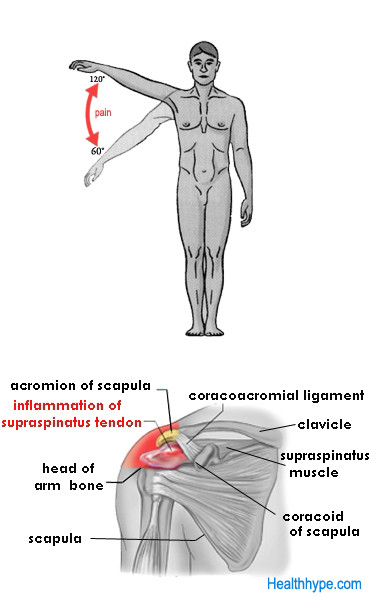Supraspinatus Tendon – Tendinitis, Tendinosis and Tear
This article explains terms: the supraspinatus tendon, tendon inflammation (supraspinatus tendinitis), degeneration (tendinosis) and tear.
What Is Supraspinatus Tendon?
The supraspinatus tendon attaches the supraspinatus muscle, which arise from the shoulder blade, to the head of the arm bone at the shoulder joint.
Function of Supraspinatus Muscle
The supraspinatus muscle is part of the rotator cuff – a group of muscles that move the shoulder joint. It arises from the upper part of the spine of the scapula (upper in Latin = supra; from here the name supraspinatus). The supraspinatus muscle is responsible for moving the arm up and away from the body within a range 60 and 120 degrees. When supraspinatus is injured, pain appears in this range of arm motion. Pain begins midway when lifting the arm and disappears once the arm is completely lifted – this phenomenon is called the painful arc syndrome (Picture 1).

Picture 1: Painful arc syndrome
(source: Wikipedia)
Being a part of the rotator cuff, the supraspinatus muscle also stabilizes the head of the arm bone (humerus) in the shoulder joint thereby preventing it from slipping upwards during shoulder movements.
Supraspinatus Tendinitis, Tendinosis and Tear – Mechanism and Symptoms
The supraspinatus tendon passes through a narrow tunnel below the scapular spine. A bony overgrowth (spur) or calcification of the ligament above this tunnel may hamper the smooth movement of the tendon. Constant friction on the tendon leads to inflammation known as supraspinatus tendinitis and causes pain during shoulder movements. This painful phase of the tendon injury may last for about a week or two and usually resolves spontaneously. However, persisting friction may result in tendon degeneration known as supraspinatus tendinosis. Tendinosis makes the tendon weak, but the patient often does not feel any pain and continues to use the shoulder. This may lead to a supraspinatus tendon tear. Even after a complete supraspinatus tendon tear, lifting the arm is still possible, since the function of the supraspinatus muscle is partly compensated by the other shoulder muscles. Therefore, a supraspinatus tear may not as obvious as other tendon tears, for example, Achilles tendon tear. A supraspinatus tear is insidious and may be missed altogether by the patient.
Diagnosis and Treatment
An orthopedist can recognize above mentioned disorders of the supraspinatus tendon from the upward slipping of the head of the arm bone, and the pain that typically occurs during the middle range of lifting the arm.
X-ray helps in the diagnosis of a narrow coraco-acromial arch and acromial spurs. An ultrasound can reveal tendon tears and tendinosis. MRI is the only investigation that can detect tendinitis.
Treatment of tendinitis is conservative and consists of cold compresses over the shoulder, analgesics and anti-inflammatory medications. A patient should avoid overhead arm movements within this time. Physical therapy should be started a week after starting medications and continued for a couple of months.
Treatment of tendinosis is by prolotherapy (proliferative therapy), in which certain substances that cause proliferation (growth) of the weakened tendon tissue are injected into the tendon. The procedure is also known as a non-surgical reconstruction of the tendon. At least two or three injections during the two weeks are required for best results. When prolotherapy is not available, steroid injections can be used, but these only limit the degeneration process and do not aid to active healing of the tendon.
Check the treatment of a torn rotator cuff.
Surgical or conservative treatment of a supraspinatus tendon injury at an early stage can result in the full resolution of symptoms. However, if treatment is delayed, permanent damage to the shoulder joint may occur, with the end-result being a stiff and weak shoulder joint.
Related Articles:



